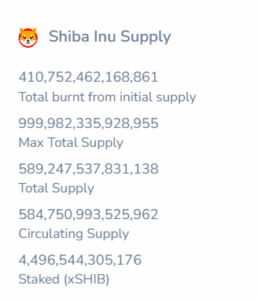Many in the crypto world dream of meme tokens “going to the moon.” Among them, one of the most repeated questions is: Can Shiba Inu (SHIB) ever hit $1?
In short: under current conditions, no — the odds are extremely low. But to understand why not, and where SHIB could go instead, we need to dig step by step. Let’s break it down in simple terms.
The Simple Math Behind the $1 Dream
Right now, there are around 589 trillion SHIB tokens in circulation. The token trades at roughly $0.000012, giving it a market cap close to $7 billion.
If SHIB price were ever to hit $1, its total market value would jump to $589 trillion. To put that in perspective, that’s 5 times larger than the entire global economy — not just the crypto market, but the whole world’s GDP combined.
Even Bitcoin (BTC), the largest cryptocurrency in history, has never crossed a $3 trillion market cap. So for SHIB to reach $1, the entire world would need to pour hundreds of trillions of dollars into a meme coin. That alone shows how unrealistic the goal is under current conditions.
Why SHIB Burns Won’t Be Enough
Supporters often point to SHIB’s burn mechanism as a possible path to higher prices. Burning means sending tokens to a dead wallet so they can never be used again, reducing total supply and ideally increasing scarcity.
But here’s the problem: the current burn rate is tiny compared to what’s needed. Billions of Shiba Inu token are burned every year, but the supply sits in the hundreds of trillions. Even if burns increased tenfold, it would still take centuries to make a serious dent.

So while burning helps control inflation, it can’t magically turn a $0.000012 coin into a $1 coin unless nearly the entire supply — more than 99.999% — is permanently removed.
Even if SHIB somehow trimmed supply, it still needs demand. For its price to climb, people must be willing to buy and use SHIB at higher and higher levels. Demand has to scale.
SHIB: What is it Used For?
Here’s where things get tricky: SHIB today is still largely a meme / speculative token, rather than a utility backbone. It has projects like Shibarium (a Layer-2), ShibaSwap, NFT efforts, and more — but usage is not yet massive.
To strengthen this point, look at Shibarium’s TVL (Total Value Locked) — a key metric showing how much value users have committed to DeFi within the network. It currently stands around $1 million, far below networks like Arbitrum ($15 billion), Optimism ($6 billion), Base ($1.6 billion), and Polygon ($1 billion). Shibarium also handles only about 4,000 daily transactions, compared with millions processed daily on these Layer-2 blockchains.

In the past, Shibarium saw peaks of over $4–5 million in TVL when DeFi activity surged. But the fact that it has dipped again shows that adoption is not yet stable or deep.
Another useful metric is transaction count / network usage. Shibarium has crossed over 1 billion total transactions. Also, in recent months, daily transactions spiked significantly — in some reporting, up 115% over prior levels, registering millions of daily transactions. That shows some momentum, but again, these are early stages.
These numbers confirm what the more cautious analysts say: yes, development is happening, but it’s still far from mass adoption.
Could Anything Change That?
Let’s imagine the most extreme possibilities. What if Shiba Inu completely changed its structure — maybe burning 99% of its supply, merging into a new ecosystem, or becoming a dominant crypto for payments? Technically, those things could increase value. But realistically, the odds are close to zero.
Even during the wild 2021 bull run, when meme coins exploded and SHIB gained millions of holders, the price never came close to one cent, let alone one dollar. That shows how far the dream really is — even in the most euphoric market conditions.
A More Realistic Future for SHIB
Instead of chasing the $1 dream, the better question is: What can SHIB reasonably achieve?
SHIB’s ecosystem has come a long way. Shibarium exists, protocols are deployed, NFTs and metaverse plans are rolling out. As these pieces mature, SHIB could gradually see real demand, not just speculative interest.
If Shibarium TVL continues growing (e.g. back toward $4–5 million or more), if transaction volume remains robust, and if burn mechanisms gain traction, SHIB price might steadily “peel off” zeros. Hitting $0.0001 or even $0.001 over many years might be ambitious but not out of the realm of possibility. Those levels would require strong execution, not miracles.
For instance,if SHIB reached $0.001, its market cap would be around $589 billion, roughly the size of Apple or Tesla. That’s ambitious, but not impossible. Anything beyond that — especially $1 — would require economic miracles.
